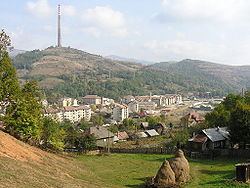Area 254.3 km² Local time Sunday 6:20 AM | County Alba County Time zone EET (UTC+2) Population 8,607 (2002) | |
 | ||
Weather 2°C, Wind NW at 2 km/h, 59% Humidity | ||
Zlatna (German: Schlatten, Goldenmarkt; Hungarian: Zalatna; Latin: Ampellum) is a town in Alba County, central Transylvania, Romania. It has a population of 8,607.
Contents
Map of Zlatna, Romania
Administration
The town administers eighteen villages: Botești (Golddorf; Botesbánya), Budeni (Higendorf), Dealu Roatei (Rotberg), Dobrot, Dumbrava, Feneș (Wildendorf; Fenes), Galați (Galz; Ompolygalac), Izvoru Ampoiului (Gross-Ompeil; Nagyompoly), Pârău Gruiului (Gruybach), Pătrângeni (Peters; Ompolykövesd ), Pirita (Pfirth), Podu lui Paul (Pauls), Runc (Goldrücken), Ruși (Rusch), Suseni (Oberdorf), Trâmpoiele (Trempojel; Kénesd), Valea Mică (Kleinwasser) and Vâltori (Waldrücken; Vultur).
Geography
Located 36 km north-west of Alba Iulia, in the Zlatna depression, the town lies at the confluence of Ampoi River with Valea Morilor creek.
Points of interest
History
A gold mining settlement has existed in the area since Roman times, when it was known as a municipium under the name of Ampellum. The name Zlatna (derived from the Slavic term for gold) was first recorded in a 1347 document. In 1387, it was awarded town status. During 1619-1620 Gabriel Bethlen, brought to Zlatna a few hundred German and Slovakian settlers for mining work. Tellurium was first discovered in a Zlatna mine in 1782 by Austrian mineralogist Franz-Joseph Müller von Reichenstein. Zlatna regained its town status in 1968, after a time when it was officially a commune.
